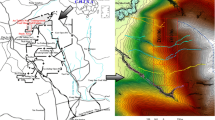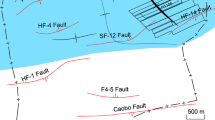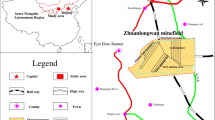Abstract
To resolve issues of water resource conservation and avoid water inrush accidents, a case study was performed in the Gaozhuang coal mine, which lies under Weishan Lake. The two coal seams are 4 and 5 m thick, and are separated by 2–5 m. As the goaf gradually expanded with mining, some fractures that had formed at the centre of the goaf were gradually compressed and closed, while fractures at the periphery of the goaf did not. Therefore, the periphery of the goaf was recognized as the key region for water conservation mining. After the upper seam was mined, the hydraulically connected fractured (HCF) zone in the overburden had a maximum height of 6.9 times of the integrated mining height. After the lower seam was mined, the HCF zone increased to a maximum height of 9.8 times the integrated mining height. The maximum depth of ground surface fractures above the goaf was 1.1 times the integrated mining height. The thickness of the safety pillar to be left in place as protective strata was determined based on these values, and the hydraulic connection between the aquifers above the mine and the overlying lake was assessed. We then analysed the feasibility of in situ protection of the surface water and proposed techniques to prevent the water in the overlying sandstone from rushing into the work area.
Zusammenfassung
Im Gaozhuang Kohlenbergbau unter dem Weishan See wurde eine Fallstudie ausgeführt, um Fragen des Schutzes von Wasserressourcen und der Vermeidung von Wassereinbrüchen zu klären. Die zwei Kohlenflöze haben eine Mächtigkeit von 4 bzw. 5 m, getrennt durch ein Zwischenmittel von 2-5 m. Mit zunehmender Ausdehnung des Bruchfeldes mit dem Abbau wurden Spalten im Bruchfeldzentrum langsam zusammengepresst und geschlossen, nicht jedoch randliche Brüche und Spalten. Somit wurde die Peripherie des Bruchfeldes als Schlüssel für einen wassererhaltenden Abbau erkannt. Nach dem Abbau des hangenden Flözes erreichte die Zone hydraulisch verbundener Brüche (HCF) eine maximale Höhe von 9.8 mal der Abbaumächtigkeit. Nach Gewinnung des liegenden Flözes wuchs die HCF-Zone auf eine maximale Höhe von 9.8 mal der gesamten Abbauhöhe. Die maximale Tiefe von Brüchen und Spalten an der Oberfläche erreichte 1.1 mal der integrierten Abbauhöhe. Auf diesen Befunden basierend wurde die Mächtigkeit des Sicherheitspfeilers bestehend aus schützenden Schichten berechnet. Die hydraulische Konnektivität zwischen den Aquiferen über der Mine und dem darüber liegenden See wurde bewertet. Danach analysieren wir die Durchführbarkeit von in situ Maßnahmen für den Schutz des Oberflächenwassers und empfehlen Techniken zur Vermeidung von Wassereinbrüchen aus den hangenden Sandsteinen in die Grubenhohlräume.
Resumen
Para resolver los problemas de conservación de los recursos hídricos y evitar los accidentes de irrupción de agua, se realizó un estudio de caso en la mina de carbón Gaozhuang, que se encuentra debajo del lago Weishan. Las dos capas de carbón tienen un espesor de 4 y 5 m y están separadas por 2-5 m. A medida que el túnel se expandía gradualmente con la minería, algunas fracturas que se habían formado en el centro del túnel se comprimieron y cerraron gradualmente, mientras que las fracturas en la periferia del túnel no lo hicieron. Es por eso que la periferia del túnel es la región clave para la conservación de agua en la minería. Después de que se explotó la veta superior, la zona fracturada conectada hidráulicamente (HCF) e tenía una altura máxima de 6,9 veces la altura de la zona extraída. Luego de explotar la veta inferior, la zona de HCF aumentó a una altura máxima de 9,8 veces la altura de extracción. La profundidad máxima de las fracturas de la superficie del suelo sobre el túnel fue 1,1 veces la altura de extracción. El grosor del pilar de seguridad, para ser dejado en el lugar como protección, se determinó en función de aquellos valores y se evaluó la conexión hidráulica entre los acuíferos que se encuentran sobre la mina y el lago suprayacente. Luego, analizamos la viabilidad de la protección in situ de las aguas superficiales y propusimos técnicas para evitar que el agua de la piedra arenisca que se encuentra encima irrumpa en el área de trabajo.
摘要
为保护水资源和避免突水事故, 在郭庄矿进行了微山湖下采煤案例研究。两个煤层分别厚4 m 和 5 m,相距仅 2-5 m。 随采空区扩展,采空区中心早期形成的裂隙逐渐压缩和闭合,但是采空区边界裂隙并非如此。 采空区边界被视为水资源保护的关键区域。上部煤层开采后,覆岩导水裂隙带最大高度为综合采高的6.9倍; 下部煤层开采之后,导水裂隙带提高到综合开采高度的9.8倍。采空区以上地表裂缝最大深度是综合开采高度的 1.1 倍。依据以上结果确定了安全煤柱厚度, 评价了煤矿以上含水层与湖水之间水力联系。我们分析了保护地表水的可行性,提出了阻止上覆砂岩突水的技术措施。













Similar content being viewed by others
References
Adhikary DP, Guo H (2014) Measurement of longwall mining induced strata permeability. Geotech Geol Eng 32(3):617–626
Cherubini CA (2008) modeling approach for the study of contamination in a fractured aquifer. Geotech Geol Eng 26(5):519–533
Coggan J, Gao F, Stead D, Elmo D (2012) Numerical modelling of the effects of weak immediate roof lithology on coal mine roadway stability. Int J Coal Geol 90–91(1):100–109
Fan LM, Ma XD, Ji RJ (2015) Progress in engineering practice of water-preserved coal mining in western eco-environment frangible area. J Chin Coal Soc 40(8):1711–1717 (in Chinese)
Forster IR, Enever J (1992) Hydrogeological response of overburden to underground mining. Off Energy Rep 1:104
Galvin JM (2016) Ground engineering-principles and practices for underground coal mining. Springer, Switzerland
Gao YF (1996) Rock shift “four band” model and dynamic displacement back analysis. J Chin Coal Soc 1:51–56 (in Chinese)
Gao BB, Liu YP, Pan JY, Yuan T (2014) Detection and analysis of height of water flowing fractured zone in underwater mining. Chin J Rock Mech Eng s1:3384–3390 (in Chinese)
Guo JS, Ma LQ, Wang Y, Wang FT (2017) Hanging wall pressure relief mechanism of horizontal section top-coal caving face and its application—a case study of the Urumqi coalfield, China. Energies 10(9):1371
Howladar FM (2013) Coal mining impacts on water environs around the Barapukuria coal mining area, Dinajpur, Bangladesh. Environ Earth Sci 70(1):215–226
Hu YZ, Liu CQ, Liu CY, Xhen BB (2015) Development regularity of mining-induced fractures in mixed mining of coal seam group. J Min Saf Eng 32(3):396–400 (in Chinese)
Kendorski FS (1993) Some modes of deformation and failure of lined tunnels. Int J Rock Mech Min 30(7):1497–1501
Luan YC, Li JT, Ban XH, Shang CY, Zhang CQ, Ma DP (2010) Observational research on the height of water flowing fractured zone in repeated mining of short-distance coal seams. J Min Saf Eng 27(1):143–146 (in Chinese)
Luan YC, Li JT, Liu N, Liu Y, Luan HX, Ma DP (2012) Research on overlying strata and surface movement rule in repeated mining. J Min Saf Eng 29(1):90–94 (in Chinese)
Ma LQ, Cao XQ, Liu Q, Zhou T (2013) Simulation study on water-preserved mining in multi-excavation disturbed zone in close-distance seams. Environ Eng Manag J 12(9):1849–1853
Ma LQ, Jin ZY, Liang JM, Sun H, Zhang DS, Li P (2015) Simulation of water resource loss in short-distance coal seams disturbed by repeated mining. Environ Earth Sci 74(7):5653–5662
Majdi A, Hassani FP, Nasiri MY (2012) Prediction of the height of destressed zone above the mined panel roof in longwall coal mining. Int J Coal Geol 98(1):62–72
Maximovich N, Khayrulina E (2014) Artificial geochemical barriers for environmental improvement in a coal basin region. Environ Earth Sci 72(6):1915–1924
Moon J, Jeong S (2011) Effect of highly pervious geological features on ground-water flow into a tunnel. Eng Geol 117(3):207–216 (in Chinese)
Palchik V (2010) Experimental investigation of apertures of mining-induced horizontal fractures. Int J Rock Mech Min 47(3):502–508
Qian MG, Miao XX (1995) Theoretiacal analysis on the structukal form and stability of overlying strata in longwall mining. Chin J Rock Mech Eng 14(2):97–106 (in Chinese)
Shi LQ, Xin HQ, Zhai PH, Li SC, Liu TB, Yan Y, Wei WX (2012) Calculating the height of water flowing fracture zone in deep mining. J Chin Univ Min Technol 41(1):37–41 (in Chinese)
Sui WH, Hang Y, Ma LX, Wu ZY, Zhou YJ, Long GQ, Wei LB (2015) Interactions of overburden failure zones due to multiple-seam mining using longwall caving. Bull Eng Geol Environ 74(3):1019–1035
Wang ZX, Zhang WQ, Zhao DS (2008) Continuous exploration for deformation and failure of overburdens under injecting grouts in separate layers. Chin J Geol Eng 30(7):1094–1098 (in Chinese)
Wang ZX, Zhao DS, Xia HC, Fan C (2013) The hazard geo-analysis of water inrush of mining of thick coal seam under reservoir. J Chin Coal Soc 38(a02):370–376 (in Chinese)
Wang FT, Tu SH, Zhang C, Zhang YW, Bai QS (2016) Evolution mechanism of water-flowing zones and control technology for longwall mining in shallow coal seams beneath gully topography. Environ Earth Sci 75(19):1309
Whittaker BN, Reddish DJ (1989) Subsidence occurrence, prediction and control. Elsevier, Amsterdam
Xu JL, Ju JF (2011) Structural morphology of key stratum and its influence on strata behaviors in fully-mechanized face with super-large mining height. Chin J Rock Mech Eng 30(8):1547–1556 (in Chinese)
Xu JL, Zhu WB, Wang XZ (2012) New method to predict the height of fractured water-conducting zone by location of key strata. J Chin Coal Soc 37(5):762–769 (in Chinese)
Yang YG, Wang J, Yu YJ (2015) Effects of different coal safe mining sequence under river on height of water flowing fracture zone. J Chin Coal Soc 40(s1):27–32 (in Chinese)
Yang SQ, Chen M, Jing HW, Chen KF, Meng B (2016) A case study on large deformation failure mechanism of deep soft rock roadway in Xin’An coal mine, China. Eng Geol 217:89–101
Zhang YJ (2010) Research on failure height and characteristic of overlying strata in mining coal seams with small interval. Coal Min Technol 15(6):9–11 (in Chinese)
Zhang DS, Fan GW, Liu YD, Ma LQ (2010) Field trials of aquifer protection in longwall mining of shallow coal seams in China. Int J Rock Mech Min 47(6):908–914
Zhang DS, Fan GW, Ma LQ, Wang XF (2011a) Aquifer protection during longwall mining of shallow coal seams: a case study in the Shendong Coalfield of China. Int J Coal Geol 86(2):190–196
Zhang QC, Li JH, Liu BS, Chen XJ (2011b) Directional drainage grouting technology of coal mine water damage treatment. Proc Eng 26:264–270
Zhang Y, Zhang CL, Zhao P (2015) Dynamic evolution rules of mining-induced fractures in different floor area of short-distance coal seams. J Min Saf Eng 40(4):786–792 (in Chinese)
Zhao BC, Liu ZR, Tong C, Wang CL (2015) Relation between height of water flowing fractured zone and mining parameters. J Min Saf Eng 32(4):634–638 (in Chinese)
Zuo JP, Sun YJ, Wang JT, Shi Y, Wen JT (2018) Mechanical and numerical analysis of “analogous hyperbola” movement of overlying strata after full mining extraction. J Min Saf Eng 1:71–77 (in Chinese)
Acknowledgements
This work was supported by the Fundamental Research Funds for the Central Universities (2017XKQY096) and the Priority Academic Program Development of Jiangsu Higher Education Institutions.
Author information
Authors and Affiliations
Corresponding authors
Electronic supplementary material
Below is the link to the electronic supplementary material.
Fig. S-1
Curve of HCF zone’s fitting formula. (PDF 12 kb)
Fig. S-2
Subsidence curve of the overburden. (PDF 22 kb)
Fig. S-3
Methods of HCF zone observation. Hydrological observation through surface drilling (a); Underground drilling and water injection (b) (PDF 15 kb)
Fig. S-4
Observation procedures. (PDF 15 kb)
Rights and permissions
About this article
Cite this article
Ma, L., Guo, J., Liu, W. et al. Water Conservation when Mining Multiple, Thick, Closely-Spaced Coal Seams: A Case Study of Mining Under Weishan Lake. Mine Water Environ 38, 643–657 (2019). https://doi.org/10.1007/s10230-019-00610-8
Received:
Accepted:
Published:
Issue Date:
DOI: https://doi.org/10.1007/s10230-019-00610-8




